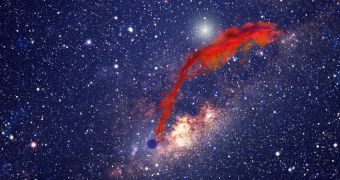When astronomers first started studying the core of the Milky Way, they found a very inhospitable environment. Despite this, new studies suggest that extrasolar planets can form around stars orbiting Sagittarius A*, the supermassive black hole powering our galaxy.
The most significant problem at this location is stellar clutter. Celestial fireballs pass very close to each other as they rush to fly past the black hole and, ever so often, one of them gets thrown towards the dark behemoth, meeting an unsavory end at the hands of gravitational and tidal forces.
An additional issue is the presence of copious volumes of radiations and supernova shock waves, which make the formation of new stars impossible, and bathe the others in X-rays and gamma-rays.
Furthermore, the fabric of spacetime itself is distorted by the close proximity to Sagittarius A*, a black hole that tips the scales at around 4.5 million solar masses. Regardless of all these phenomena, exoplanets can apparently still develop around some stars, a new study indicates.
The work, conducted by investigators at the Harvard-Smithsonian Center for Astrophysics (CfA), is centered on a massive cloud of hydrogen and helium, which was discovered heading towards the galactic core at great speed.
Astronomers believe that this object is basically a protoplanetary disk, an accumulation of debris left behind by a newly-formed star, from which new planets, asteroids and comets eventually form.
“This unfortunate star got tossed toward the central black hole. Now it's on the ride of its life, and while it will survive the encounter, its protoplanetary disk won't be so lucky,” Ruth Murray-Clay says.
The CfA astronomer is the lead author of the study, which is published in the top journal Nature.
“It's fascinating to think about planets forming so close to a black hole. If our civilization inhabited such a planet, we could have tested Einstein's theory of gravity much better, and we could have harvested clean energy from throwing our waste into the black hole,” adds study coauthor Avi Loeb.
Fortunately, if the gas in the doomed star's protoplanetary disk falls through Sagittarius A*'s event horizon, we will be notified of this event by a bright flash of X-rays from the black hole.
Thus far, astronomers managed to confirm more than 770 exoplanets, and an additional 2,300+ are awaiting further study. The NASA Kepler Telescope, launched specifically to find alien worlds, is continuing its scans of the night sky, and will probably produce even more candidates.

 14 DAY TRIAL //
14 DAY TRIAL //